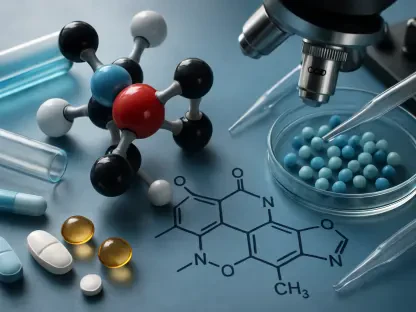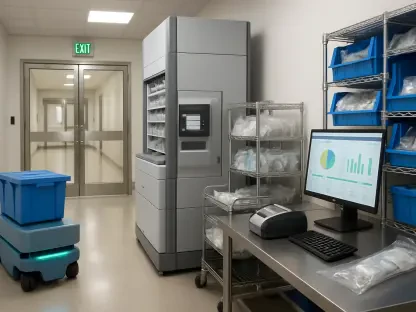In the quest for effective cancer therapies, scientists at the Sylvester Comprehensive Cancer Center at the University of Miami have embarked on groundbreaking research on the molecule TAF1. This DNA regulatory entity plays a pivotal role in hematopoiesis—the complex process of blood cell formation from stem cells. Recent findings, appearing in Developmental Cell, propose that manipulating TAF1 can potentially lead to innovative cancer treatments, particularly acute myeloid leukemia (AML), while preserving healthy blood cells. This research is promising for cancer therapies that target transcriptional regulators without compromising essential physiological functions.
Understanding TAF1’s Role in Hematopoiesis
A Closer Look at Lineage Commitment
TAF1 acts as a crucial regulator of genes necessary for hematopoiesis, with an important focus on blood cell lineage commitment. This process involves hematopoietic stem cells (HSCs) in the bone marrow, which differentiate into various cell types like immune cells, platelets, and red blood cells. Previous studies demonstrated that TAF1 has limited involvement in HSC self-renewal, distinct from its vital role in gene activation for blood cell diversification. Insights into TAF1’s role in lineage commitment may pave the way for new therapeutic approaches targeting cancer cells with precision.
Shiekhattar’s research highlights TAF1 as a molecular switch that balances stem cell maintenance with lineage commitment, challenging conventional views of its necessity throughout a cell’s life cycle. The study suggests a more nuanced role for TAF1, selectively activating genes related to cell differentiation rather than broader gene activation functions across all cellular stages. This understanding of TAF1’s specialized role could transform therapeutic strategies by allowing targeted manipulation of gene activity for cancer treatment without harming normal blood cell production.
The Unique Role During Embryonic and Adult Stages
Intriguingly, TAF1 exhibits distinct functionalities in adult blood cell development compared to embryonic phases, where blood production demands are intensified. In adults, TAF1 aids in regulating the delicate balance between stem cell maintenance and progression to mature blood cells while governing differentiation more precisely than previously assumed. This revelation introduces possibilities for targeted interventions during various developmental stages, providing new directions for therapeutic research and applications tailored to both adult and embryonic hematopoiesis processes.
The discovery that adult hematopoietic stem cells can thrive without TAF1 changes the landscape of potential treatments and raises new questions regarding its role across different life phases. While TAF1 plays a central role in differentiation-related programs, its absence does not impede self-renewal, uncoupling these functions in a manner that was unexpected. The implications of this finding extend beyond theoretical insights, offering practical pathways in terms of developing therapies that can potentially disrupt cancer growth without damaging necessary blood cell generation.
Implications for Cancer Treatment
TAF1’s Dual Functionality in Transcription
TAF1 serves dual purposes in transcription, not only by initiating gene transcription but also by mitigating inhibitory elements within the process, adding layers to its regulatory capabilities. For cancer treatment, understanding this dual function is vital, highlighting TAF1’s unique ability to control gene activation selectively. Such knowledge can guide researchers in designing agents that selectively target TAF1’s action in oncogenic contexts, offering hope for addressing other cancers affecting stem cell compartments, including in organs like the colon or brain, where similar mechanisms may operate.
With these revelations, the field of cancer research opens a frontier for TAF1-targeting agents. These agents are currently in the developmental phases for eventual clinical application. By leveraging TAF1’s transcriptional regulatory functions, researchers aim to exert control over oncogenic pathways specifically, reducing cancer proliferation while sparing normal cell processes. This effort holds significant promise for more refined therapies, possibly minimizing the side effects that often accompany existing cancer treatments by focusing efforts on transcriptional regulation at the molecular level.
Targeted Therapeutic Approaches
Addressing one of the pivotal challenges in hematology, the research investigates how to eliminate cancer cells without impairing normal blood cell production. TAF1 inhibitor development could satisfy this criterion by leaving HSC self-renewal and essential lineage differentiation processes intact. The discovery clearly indicates that targeting TAF1 does not disrupt regular blood formation, establishing an essential threshold for developing therapies that are potent yet non-disruptive to blood cell health. This insight is crucial in shaping next-generation treatments for hematologic malignancies.
Furthermore, the research identifies opportunities to utilize TAF1 effectively in in vitro HSC expansion, enhancing stem cell transplantation outcomes. Strategies harnessing this knowledge could advance medical practices significantly, ensuring that stem cell transplants remain efficient and robust. These applications not only promise improvements in clinical strategies but also reaffirm the potential of transcriptional regulation in advancing cancer therapy, setting the stage for further innovations in cancer epigenetics and overarching treatment methodologies.
Transformative Insights in Oncology
Researchers at the Sylvester Comprehensive Cancer Center, affiliated with the University of Miami, are pioneering efforts to advance cancer treatments by focusing their studies on a specific molecule known as TAF1. This molecule, integral to DNA regulation, plays a crucial part in the process of hematopoiesis, which is the formation of blood cells deriving from stem cells. Recently published findings in the journal Developmental Cell suggest that by altering TAF1, it may be feasible to devise new methods to treat cancers like acute myeloid leukemia (AML). The promising aspect of this approach is its potential to maintain the integrity of healthy blood cells while targeting cancerous ones. This line of research holds significant promise for developing cancer therapies that attack transcriptional regulators without adversely affecting essential biological functions, thereby advancing safer treatment options for patients.









